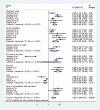Pooled prevalence of malaria and associated factors among vulnerable populations in Ethiopia: a systematic review and meta-analysis
- PMID: 39148027
- PMCID: PMC11325821
- DOI: 10.1186/s12879-024-09736-9
Pooled prevalence of malaria and associated factors among vulnerable populations in Ethiopia: a systematic review and meta-analysis
Abstract
Background: Malaria is a serious, fatal disease, and a high-risk determinant for human health globally. Children, pregnant women, and migrants are vulnerable groups for malaria infection in African regions. Recently, malaria is an endemic disease in Ethiopia.
Objectives: This study aimed to determine the pooled prevalence of malaria and its determinant factors among the most vulnerable populations in Ethiopia.
Methods: Electronic databases, including PubMed, Google Scholar, Web of Science, Semantic Scholar, and Scopus were used for searching articles published since the 2020 Gregorian calendar and onwards. All peer-reviewed Ethiopian journals, health institutions, and Universities were considered for article searching. A PRISMA flow chart and Endnote software were used for article screening, and to remove duplications, respectively. The modified version of the Newcastle-Ottawa Scale was used for potential risk of bias assessments. The heterogeneity among the included studies was evaluated using the indicator of heterogeneity (I2). Egger's test and funnel plot were used to examine the possible publication bias. A random-effects analysis was used to assess the pooled prevalence of malaria, and its determinant factors with a 95% CI. The screening process, data extraction, and quality assessment were done independently, and any disagreements were resolved through discussions.
Results: A total of twelve studies were included in this study. The pooled malaria prevalence was 11.10% (95% CI: 6.10, 16.11). Stagnant water (AOR: 4.19, 95% CI: 2.47, 7.11), no insecticide-treated net utilization (AOR: 3.15, 95% CI: 1.73, 5.73), and staying outdoors at night (AOR: 5.19, 95% CI: 2.08, 12.94) were the pooled estimated statistically risk factors for malaria prevalence. Whereas, insecticide-treated bed net utilization (AOR: 1.59, 95% CI: 0.23, 10.95) reduces the risk of malaria infection.
Conclusions: The pooled prevalence of malaria is high among vulnerable populations. Creating awareness regarding utilization of insecticide-treated bed nets, and draining stagnant water from the environment are possible interventions to reduce the prevalence of malaria.
Keywords: Ethiopia; Malaria; Meta-analysis; Prevalence; Systematic review.
© 2024. The Author(s).
Conflict of interest statement
The authors declare no competing interests.
Figures







References
-
- Control, C.f.D.P.a., What is malaria, 2023? accessed from https://www.cdc.gov/malaria/about/faqs.html, Accessed date 04 Apr 2024.
-
- 2023 World malaria repor; Accessed from https://www.who.int/teams/global-malaria-programme/reports/world-malaria..., Accessed date 29 Mar 2024.
-
- WHO report of malatria, 2023: AccessedAccessed from https://www.who.int/news-room/fact-sheets/detail/malaria, Accessed date 21 Mar 2024.
-
- Organization, W.H., Global technical strategy for malaria 2016–2030. World Health Organization; 2015. Accessed from https://iris.who.int/handle/10665/342995.
Publication types
MeSH terms
LinkOut - more resources
Full Text Sources
Medical

